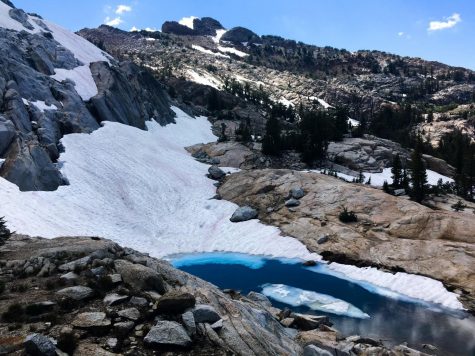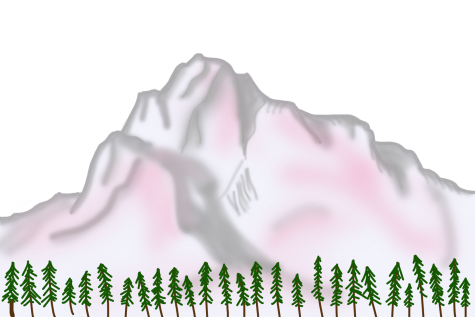Mother Nature’s snow cone
Pink snow falls on Yosemite National Park
Despite the brutal heat of summer, snow exists during this season at elevations above 9,500 feet in Yosemite National Park, but its appearance may not be what people expect: instead of the powdery white goodness often seen on mountaintops, this snow has a startling pink hue.

Pink-colored snow melts on a mountain at Yosemite National Park. Pink color is formed by a snow algae called chlamydomonas nivalis, which uses a pigment to protect itself from harsh UV rays found at high altitudes.
This strange phenomenon is caused by an algae found in melting snow that flourishes in frigid temperatures, according to a Facebook post from the park on August 4th. The snow algae, also known as Chlamydomonas nivalis, contains not only chlorophyll but also a vibrant red carotenoid pigment that acts as a sunscreen to protect the organism from harsh UV rays at high altitudes.
“The pigment dyes the surrounding area a darker color, giving the effect of a pink or red snow field, and allows the snow to heat up faster and melt more quickly,” Yosemite National Park wrote in their post.
Its unique color, as well as its faintly sweet smell, earned the algae-filled snow its tropical fruit nickname, according to Wayne’s Word, an online textbook of natural history from Palomar College.
“Compressing the snow with your boot leaves a distinct footprint the color of watermelon pulp. The snow even has a fresh watermelon scent and is sometimes called watermelon snow,” the textbook states.
Watermelon snow mostly appears during the summer, as the hot weather and abundant sunlight provides the most ideal environment for the algae to thrive.
“The algae are present in the winter, but not actively growing, and their growth is inhibited by the fact that snowfalls keep covering them,” Dr. Thomas Artiss, an upper school biology teacher, said. “In the spring and summer, temperatures warm and the algae are exposed to sunlight, and they begin to grow actively.
Sophomore Alexa Lowe, who saw the snow three years ago at Mt. Lassen, describes watermelon snow as a crimson shade whose color caught her off guard.
“I was surprised at first because I had no idea what it was,” Alexa said. “It was hard to believe it was a living organism because it really looked like blood with its bright red color that stood out from the background.”

Although the sight may seem bizarre and rare, watermelon snow was discovered more than 2000 years ago when Aristotle first wrote about colored snow, according to Wayne’s Word. At first, humans attributed the odd discoloration to oxidation products from rocks or iron deposits from meteors. It was not until the nineteenth century that scientists, with the aid of more advanced microscopic technology, determined the cause of the pink snow to be green algae that secretes a red sunscreen, according to a study published in 2006.
Some scientists believe that the algae may be relevant to predicting the effects of climate change. The red pigment the algae produces causes the snow to melt faster, which then allows for more algae growth.
“Imagine wearing a dark red T-shirt on a sunny day rather than a white one,” Dr. Artiss wrote. “It’s a classic example of a positive feedback loop, and since this algae can be found on snow all over the planet, it may well play a role in melting snow and glaciers faster than if it weren’t there.
However, unlike its namesake, watermelon snow may not be as tasty or as edible.
“As a Canadian expat, we were taught the golden rule of Canadian winters was not to eat yellow snow. Apparently, this should be extended to pink snow as well,” Dr. Artiss wrote. “It may or may not taste like watermelon, but it is apparently mildly toxic, and anecdotally, a laxative.”

Erica Cai (12) is the co-editor-in-chief of Humans of Harker, and this is her fourth year on staff. Her goals in journalism this year are to celebrate...

Catherine Feng (10) is the assistant copy editor for the Winged Post. This is her second year on staff, and she hopes to improve her journalistic skills...

Arely Sun (12) is the co-managing editor of Harker Aquila with focus on longform writing. This is her fourth year on staff, and she hopes to work with...


















![“[Building nerf blasters] became this outlet of creativity for me that hasn't been matched by anything else. The process [of] making a build complete to your desire is such a painstakingly difficult process, but I've had to learn from [the skills needed from] soldering to proper painting. There's so many different options for everything, if you think about it, it exists. The best part is [that] if it doesn't exist, you can build it yourself," Ishaan Parate said.](https://harkeraquila.com/wp-content/uploads/2022/08/DSC_8149-900x604.jpg)




![“When I came into high school, I was ready to be a follower. But DECA was a game changer for me. It helped me overcome my fear of public speaking, and it's played such a major role in who I've become today. To be able to successfully lead a chapter of 150 students, an officer team and be one of the upperclassmen I once really admired is something I'm [really] proud of,” Anvitha Tummala ('21) said.](https://harkeraquila.com/wp-content/uploads/2021/07/Screen-Shot-2021-07-25-at-9.50.05-AM-900x594.png)







![“I think getting up in the morning and having a sense of purpose [is exciting]. I think without a certain amount of drive, life is kind of obsolete and mundane, and I think having that every single day is what makes each day unique and kind of makes life exciting,” Neymika Jain (12) said.](https://harkeraquila.com/wp-content/uploads/2017/06/Screen-Shot-2017-06-03-at-4.54.16-PM.png)








![“My slogan is ‘slow feet, don’t eat, and I’m hungry.’ You need to run fast to get where you are–you aren't going to get those championships if you aren't fast,” Angel Cervantes (12) said. “I want to do well in school on my tests and in track and win championships for my team. I live by that, [and] I can do that anywhere: in the classroom or on the field.”](https://harkeraquila.com/wp-content/uploads/2018/06/DSC5146-900x601.jpg)
![“[Volleyball has] taught me how to fall correctly, and another thing it taught is that you don’t have to be the best at something to be good at it. If you just hit the ball in a smart way, then it still scores points and you’re good at it. You could be a background player and still make a much bigger impact on the team than you would think,” Anya Gert (’20) said.](https://harkeraquila.com/wp-content/uploads/2020/06/AnnaGert_JinTuan_HoHPhotoEdited-600x900.jpeg)

![“I'm not nearly there yet, but [my confidence has] definitely been getting better since I was pretty shy and timid coming into Harker my freshman year. I know that there's a lot of people that are really confident in what they do, and I really admire them. Everyone's so driven and that has really pushed me to kind of try to find my own place in high school and be more confident,” Alyssa Huang (’20) said.](https://harkeraquila.com/wp-content/uploads/2020/06/AlyssaHuang_EmilyChen_HoHPhoto-900x749.jpeg)


